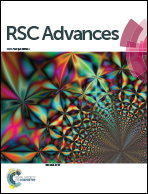New nanoplatforms based on upconversion nanoparticles and single-walled carbon nanohorns for sensitive detection of acute promyelocytic leukemia†
Abstract
A new luminescence “Turn-On” nanoplatform based on luminescence resonance energy transfer (LRET) from sodium citrate functionalized upconversion nanoparticles (Cit-UCNPs, energy donor) to single-walled carbon nanohorns (SWCNHs, energy acceptor) was prepared for sensitive detection of acute promyelocytic leukemia (APL). In the presence of the target DNA, a PML/RARα fusion gene of APL, the π–π stacking interaction between the energy donor Cit-UCNPs and energy acceptor SWCNHs weakened and their distance enlarged. Therefore, the luminescence of Cit-UCNPs would be recovered (turn on) due to the inhibition of the LRET process. Based on this fact, a sensitive method was developed for the fluorescence turn on detection of ALP with a detection limit as low as 0.28 nM. To the best of our knowledge, this is the first time that upconversion nanoparticles and single-walled carbon nanohorns were used as a donor–acceptor pair to detect PML/RARα fusion gene sequences through a LRET process.


 Please wait while we load your content...
Please wait while we load your content...